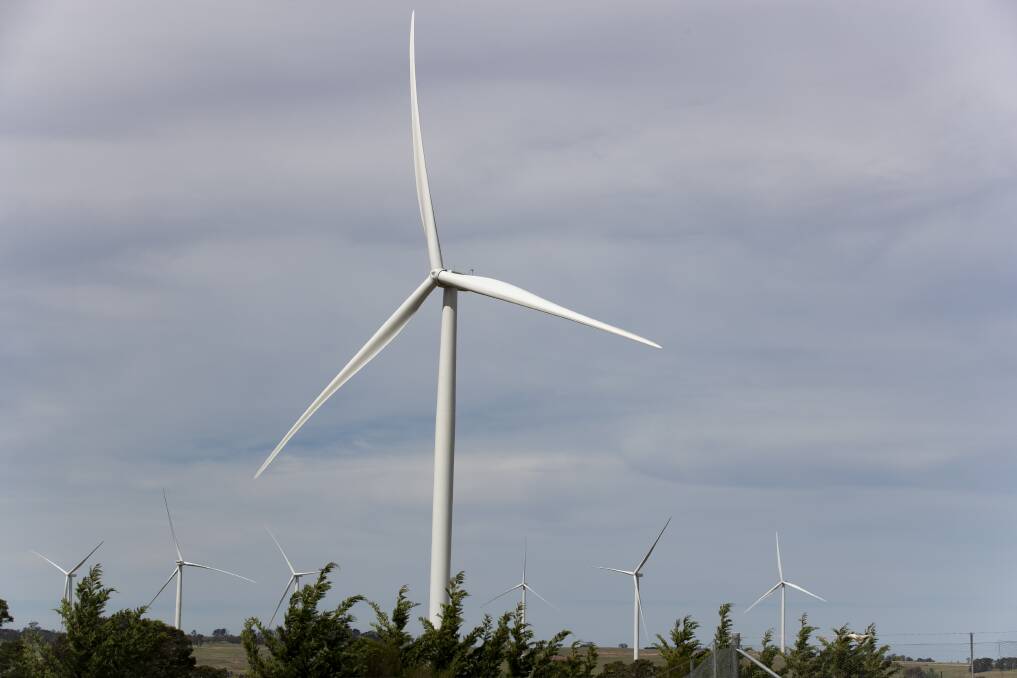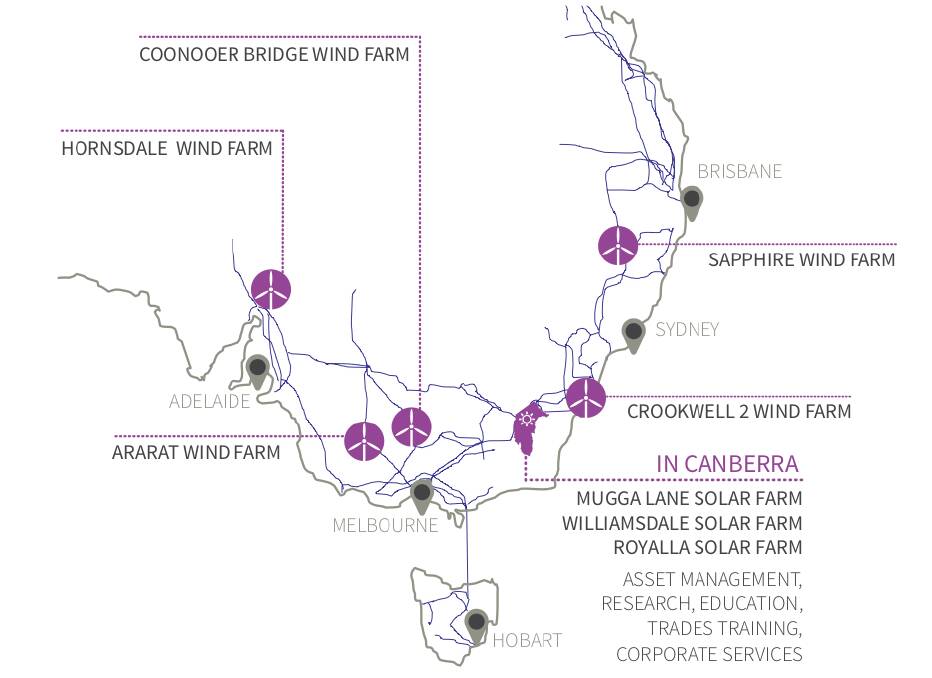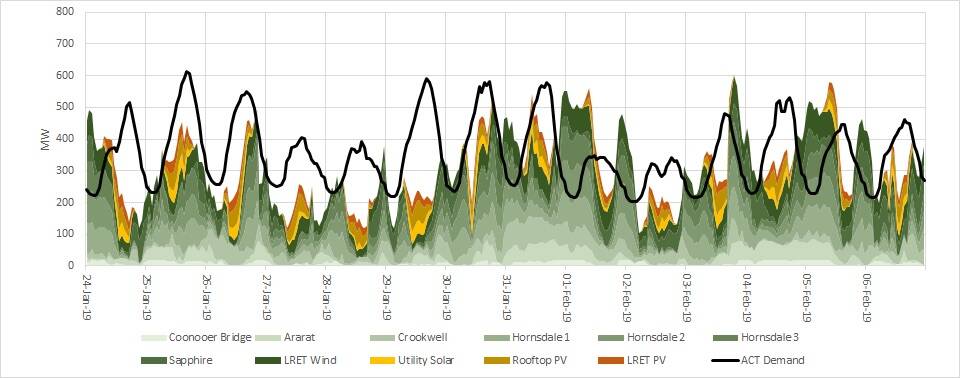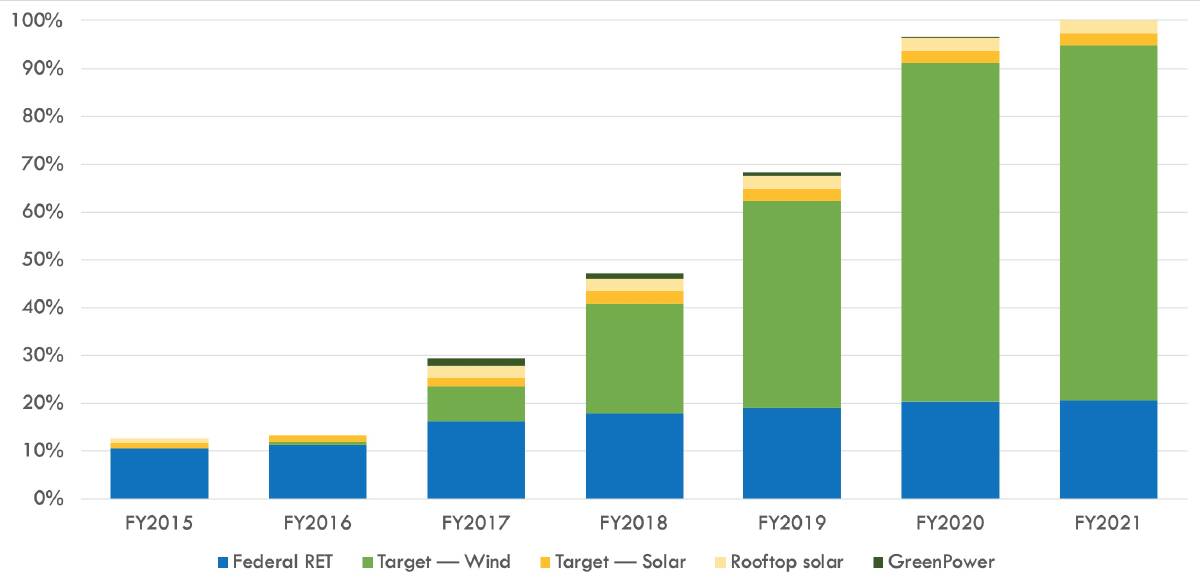While our representatives on Capital Hill dither, fail to address and flat out lie about Australia's increasing carbon emissions, exactly three kilometers away, the quiet achievers in ACT's Legislative Assembly are a beacon of success.
Subscribe now for unlimited access.
$0/
(min cost $0)
or signup to continue reading

New data out this week shows the wind farms powering the ACT's ambitious climate policy are reducing carbon pollution at one-third the cost of the government's Carbon Solutions Fund.
The five wind farms contributing to the territory's 100 per cent Renewable Energy Target generated 1.3 TWh of energy last year, more power than is used by all the households in the territory combined, at a cost equivalent to $4.36 per tonne of carbon dioxide. Meanwhile, the federal government's signature carbon scheme is writing contracts for $14.17 per tonne.
The ACT's achievement stems from steady work begun in 2014, right around the time Tony Abbott was killing off Australia's carbon price and pruning the federal Renewable Energy Target.
The territory that houses the seat of federal government is committed to achieving carbon neutrality by 2045 and is well on its way, on track to reduce emissions to 40 per cent below 1990 levels by 2020. (Every state and territory, with the exception of the Northern Territory, has now followed with a commitment to decarbonising before mid-century.)
Meanwhile with every passing quarter, the federal government slips further from achieving its target of 26-28 percent reduction on 2005 levels by 2030, falling way short of Australia's share of keeping global warming to 1.5 degrees.
Central to the ACT's efforts is an ambitious 100 per cent by 2020 renewable energy target. As its first act, the territory's government ran a series of reverse-auctions, under which five wind farms and four solar farms were given 20 year fixed-price contracts for their energy and renewable energy certificates.

The solar projects in the program have received the majority (69 per cent) of the program's financial support but represent only a minority (11 per cent) of the generation. These solar projects - some of the largest in the country at the time of construction - were an important stepping stone in solar's stunningly fast increase in scale and decrease in costs.
On top of the nine projects built under the auction, the territory's target relies on its share of the federal renewable energy target, both large scale renewables and household solar, plus a small and decreasing amount through the GreenPower scheme.
Some, including Australian entrepreneur Dick Smith, have criticised (nitpicked?) the ACT government's labelling of the target as "100 per cent renewable" given that the region's demand is not matched with renewable generation every second of every day.
The ACT government is careful to say "the 100 per cent target is a 'net' target. Sometimes our fleet of generators will produce more than the territory needs, sometimes less. Over the course of 2020 we estimate this will net out to ensure the 100 per cent target is met."
Just how much of the ACT's energy is satisfied by renewables in real-time is a question that intrigued Dr David Osmond, senior wind engineer at Windlab, one of several renewable energy companies based in Canberra. Osmond has taken a fine-grained look at the territory's energy demand data as well as the output of the renewable generators participating in target, including the 192 wind turbines and 177,340 solar panels installed as a result of the reverse auctions. Osmond found that 74 per cent of the territory's demand could theoretically be supplied by the renewables "fleet" underpinning the 100 per cent target. As more renewable energy and more storage come online this number will only increase.
In a sense the territory uses the grid like a bank. ACT Minister for Climate Change Shane Rattenbury explains the "net" target with an analogy, arguing that the electricity market "is like depositing $100 in the bank and then withdrawing $100 from an ATM, you don't receive the same note you deposited, but you still have $100".

The ACT's 100 per cent renewable scheme was originally estimated to cost each household $5.20 per week, but the impost currently sits at less than $1 a week, largely because the level of subsidy required for renewables has plummeted in recent years. It's a recurring theme for renewables - targets are met early and delivered well below cost estimates.
Mindful of the impact of even small additional costs to householders, the territory government developed a parallel energy efficiency program that has been taken up by about half of the region's households, saving an estimated $5.80 per week per household and an estimated 739,000 tonnes of carbon dioxide by 2020.
The territory has recently announced an upcoming auction for more renewable energy, to help it keep up with growth through to the end of the next decade, and it will soon install a large battery to provide grid services.
Now that electricity is effectively dealt with, the focus is on the next biggest sectors - transport and buildings.

The territory government has committed to transitioning all of its buses to zero emissions by 2040 and its 600 car vehicle fleet by 2022. Early indications are that over a four year lease cycle, electric vehicles are cheaper to own.
The government will phase out piped natural gas by 2045 and this week announced the end to mandatory gas connections for new subdivisions. All government buildings will be moving to all electric - meaning no more gas boilers. To show the way, the recently opened Margaret Hendy School is the first to be built without a gas connection.
In a bold move, the territory government is changing the rules to prohibit it from using carbon offsets to meet its targets.
It's important to note how uncontroversial the territory's targets have been. Delivered under by the Labor-Greens power sharing government, ACT Liberal representatives have, to a large degree, not stood in the way.
Back in April 2014, Angus Taylor, well into his anti-renewables crusade, held a media stunt on the top of Red Hill and disparaged the ACT's newly announced renewable energy target. ''The simple numbers tell us that what is being proposed by the ACT government is three times more expensive than alternatives for generating electricity, and 10 times more expensive than alternatives for reducing carbon emissions," he said.
We now know that wind energy has delivered carbon abatement for a fraction of the cost of alternatives, and local electricity costs remain among the cheapest in the country. True to form, Taylor's claims about renewables were very wrong. But maybe we should cut him some slack; it was April Fools' Day after all.
If the Federal Minister for Emissions Reduction really intends to reduce emissions, he need look no further than the nation's capital for a stunningly successful example.
- Simon Holmes à Court is senior adviser to the Climate and Energy College at Melbourne University and can be found on Twitter at @simonahac

